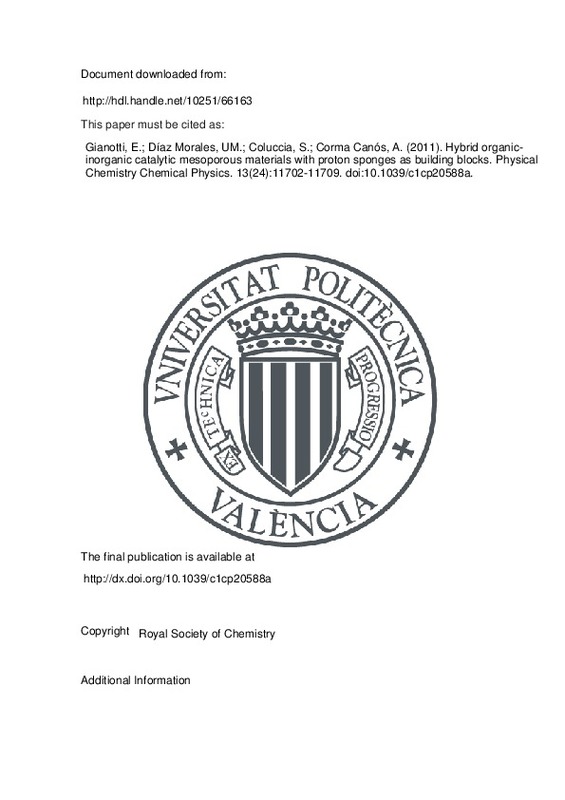Hoffmann, F., Cornelius, M., Morell, J., & Fröba, M. (2006). Silica-Based Mesoporous Organic–Inorganic Hybrid Materials. Angewandte Chemie International Edition, 45(20), 3216-3251. doi:10.1002/anie.200503075
Sanchez, C., Rozes, L., Ribot, F., Laberty-Robert, C., Grosso, D., Sassoye, C., … Nicole, L. (2010). «Chimie douce»: A land of opportunities for the designed construction of functional inorganic and hybrid organic-inorganic nanomaterials. Comptes Rendus Chimie, 13(1-2), 3-39. doi:10.1016/j.crci.2009.06.001
Sanchez, C., Julián, B., Belleville, P., & Popall, M. (2005). Applications of hybrid organic–inorganic nanocomposites. Journal of Materials Chemistry, 15(35-36), 3559. doi:10.1039/b509097k
[+]
Hoffmann, F., Cornelius, M., Morell, J., & Fröba, M. (2006). Silica-Based Mesoporous Organic–Inorganic Hybrid Materials. Angewandte Chemie International Edition, 45(20), 3216-3251. doi:10.1002/anie.200503075
Sanchez, C., Rozes, L., Ribot, F., Laberty-Robert, C., Grosso, D., Sassoye, C., … Nicole, L. (2010). «Chimie douce»: A land of opportunities for the designed construction of functional inorganic and hybrid organic-inorganic nanomaterials. Comptes Rendus Chimie, 13(1-2), 3-39. doi:10.1016/j.crci.2009.06.001
Sanchez, C., Julián, B., Belleville, P., & Popall, M. (2005). Applications of hybrid organic–inorganic nanocomposites. Journal of Materials Chemistry, 15(35-36), 3559. doi:10.1039/b509097k
Wight, A. P., & Davis, M. E. (2002). Design and Preparation of Organic−Inorganic Hybrid Catalysts. Chemical Reviews, 102(10), 3589-3614. doi:10.1021/cr010334m
Vallé, K., Belleville, P., Pereira, F., & Sanchez, C. (2006). Hierarchically structured transparent hybrid membranes by in situ growth of mesostructured organosilica in host polymer. Nature Materials, 5(2), 107-111. doi:10.1038/nmat1570
Kapoor, M. P., & Inagaki, S. (2006). Highly Ordered Mesoporous Organosilica Hybrid Materials. Bulletin of the Chemical Society of Japan, 79(10), 1463-1475. doi:10.1246/bcsj.79.1463
Damrau, U., & Marsmann, H. C. (1994). The hydrolysis of oligomer intermediates in the sol-gel process. Journal of Non-Crystalline Solids, 168(1-2), 42-48. doi:10.1016/0022-3093(94)90118-x
Raman, N. K., Ward, T. L., Brinker, C. J., Sehgal, R., Smith, D. M., Duan, Z., … Headley, T. J. (1993). Catalyst dispersion on supported ultramicroporous inorganic membranes using derivatized silylation agents. Applied Catalysis A: General, 96(1), 65-82. doi:10.1016/0926-860x(93)80007-d
Boury, B., & Corriu, R. J. P. (2002). Auto-organisation of hybrid organic–inorganic materials prepared by sol–gel chemistry. Chemical Communications, (8), 795-802. doi:10.1039/b109040m
Mehdi, A., Reye, C., & Corriu, R. (2011). From molecular chemistry to hybrid nanomaterials. Design and functionalization. Chem. Soc. Rev., 40(2), 563-574. doi:10.1039/b920516k
Pope, E. J. A., & Mackenzie, J. D. (1986). Sol-gel processing of silica. Journal of Non-Crystalline Solids, 87(1-2), 185-198. doi:10.1016/s0022-3093(86)80078-3
Winter, R., Chan, J.-B., Frattini, R., & Jonas, J. (1988). The effect of fluoride on the sol-gel process. Journal of Non-Crystalline Solids, 105(3), 214-222. doi:10.1016/0022-3093(88)90310-9
Reale, E., Leyva, A., Corma, A., Martínez, C., García, H., & Rey, F. (2005). A fluoride-catalyzed sol–gel route to catalytically active non-ordered mesoporous silica materials in the absence of surfactants. Journal of Materials Chemistry, 15(17), 1742. doi:10.1039/b415066j
Díaz, U., García, T., Velty, A., & Corma, A. (2009). Hybrid organic–inorganic catalytic porous materials synthesized at neutral pH in absence of structural directing agents. Journal of Materials Chemistry, 19(33), 5970. doi:10.1039/b906821j
Alder, R. W. (1989). Strain effects on amine basicities. Chemical Reviews, 89(5), 1215-1223. doi:10.1021/cr00095a015
Llamas-Saiz, A. L., Foces-Foces, C., & Elguero, J. (1994). Proton sponges. Journal of Molecular Structure, 328, 297-323. doi:10.1016/0022-2860(94)08367-3
Howard, S. T. (2000). Relationship between Basicity, Strain, and Intramolecular Hydrogen-Bond Energy in Proton Sponges. Journal of the American Chemical Society, 122(34), 8238-8244. doi:10.1021/ja0010094
Rodriguez, I., Sastre, G., Corma, A., & Iborra, S. (1999). Catalytic Activity of Proton Sponge: Application to Knoevenagel Condensation Reactions. Journal of Catalysis, 183(1), 14-23. doi:10.1006/jcat.1998.2380
CLIMENT, M., CORMA, A., DOMINGUEZ, I., IBORRA, S., SABATER, M., & SASTRE, G. (2007). Gem-diamines as highly active organocatalysts for carbon–carbon bond formation. Journal of Catalysis, 246(1), 136-146. doi:10.1016/j.jcat.2006.11.029
Sing, K. S. W. (1985). Reporting physisorption data for gas/solid systems with special reference to the determination of surface area and porosity (Recommendations 1984). Pure and Applied Chemistry, 57(4), 603-619. doi:10.1351/pac198557040603
Barrett, E. P., Joyner, L. G., & Halenda, P. P. (1951). The Determination of Pore Volume and Area Distributions in Porous Substances. I. Computations from Nitrogen Isotherms. Journal of the American Chemical Society, 73(1), 373-380. doi:10.1021/ja01145a126
Woźniak, K. (1996). Proton sponges: solid-state NMR spectra of ionic complexes of 1,8-bis(dimethylamino)naphthalene. Journal of Molecular Structure, 374(1-3), 317-326. doi:10.1016/0022-2860(95)08947-0
Pozharskii, A. F. (1998). Naphthalene «proton sponges». Russian Chemical Reviews, 67(1), 1-24. doi:10.1070/rc1998v067n01abeh000377
Seo, Y.-K., Park, S.-B., & Ho Park, D. (2006). Mesoporous hybrid organosilica containing urethane moieties. Journal of Solid State Chemistry, 179(4), 1285-1288. doi:10.1016/j.jssc.2006.01.021
Kawahara, K., Hagiwara, Y., Shimojima, A., & Kuroda, K. (2008). Stepwise silylation of double-four-ring (D4R) silicate into a novel spherical siloxane with a defined architecture. Journal of Materials Chemistry, 18(27), 3193. doi:10.1039/b807533f
Van Meervelt, L., Platteborze, K., & Zeegers-Huyskens, T. (1994). X-Ray and Fourier-transform infrared studies of 1,8-bis(dimethylaminomethyl)naphthalene. Comparison with 1,8-bis(dimethylamino)naphthalene. Journal of the Chemical Society, Perkin Transactions 2, (5), 1087. doi:10.1039/p29940001087
Brzeziński, B., Schroeder, G., Grech, E., Malarski, Z., & Sobczyk, L. (1992). Basicity, IR spectra and protonation of some proton sponges in acetonitrile. Journal of Molecular Structure, 274, 75-82. doi:10.1016/0022-2860(92)80147-a
Rodriguez, I., Iborra, S., Rey, F., & Corma, A. (2000). Heterogeneized Brönsted base catalysts for fine chemicals production: grafted quaternary organic ammonium hydroxides as catalyst for the production of chromenes and coumarins. Applied Catalysis A: General, 194-195, 241-252. doi:10.1016/s0926-860x(99)00371-3
CLIMENT, M. (2004). Increasing the basicity and catalytic activity of hydrotalcites by different synthesis procedures. Journal of Catalysis, 225(2), 316-326. doi:10.1016/j.jcat.2004.04.027
Prout, F. S., Beaucaire, V. D., Dyrkacz, G. R., Koppes, W. M., Kuznicki, R. E., Marlewski, T. A., … Puda, J. M. (1973). Konevenagel Reaction. Kinetic study of the reaction of (+)-3-methyl-cyclohexanone with malononitrile. The Journal of Organic Chemistry, 38(8), 1512-1517. doi:10.1021/jo00948a015
Guyot, J., & Kergomard, A. (1983). Cinétique et mécanisme de la réaction de knoevenagel dans le benzène—1. Tetrahedron, 39(7), 1161-1166. doi:10.1016/s0040-4020(01)91879-4
Motokura, K., Tanaka, S., Tada, M., & Iwasawa, Y. (2009). Bifunctional Heterogeneous Catalysis of Silica-Alumina-Supported Tertiary Amines with Controlled Acid-Base Interactions for Efficient 1,4-Addition Reactions. Chemistry - A European Journal, 15(41), 10871-10879. doi:10.1002/chem.200901380
[-]







![[Cerrado]](/themes/UPV/images/candado.png)


